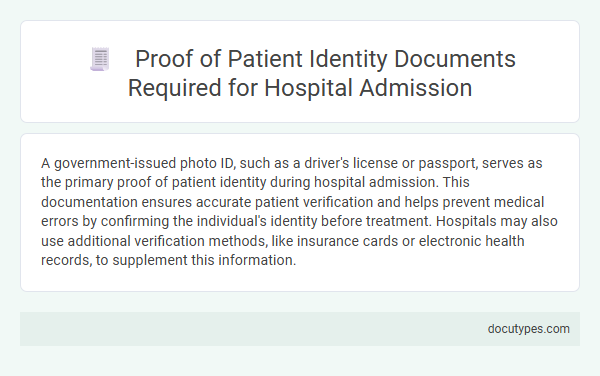A government-issued photo ID, such as a driver's license or passport, serves as the primary proof of patient identity during hospital admission. This documentation ensures accurate patient verification and helps prevent medical errors by confirming the individual's identity before treatment. Hospitals may also use additional verification methods, like insurance cards or electronic health records, to supplement this information.
Introduction to Patient Identity Verification
Patient identity verification is a crucial step during hospital admission to ensure accurate medical records and treatment. The most common document serving as proof of patient identity includes government-issued photo identification, such as a driver's license or passport. Providing Your valid ID helps healthcare providers confirm identity and avoid medical errors.
Importance of Proof of Identity in Hospitals
Proof of patient identity during hospital admission is crucial for ensuring accurate medical treatment and safeguarding patient safety. Your identity document helps healthcare providers verify who you are to deliver personalized and secure care.
- Government-issued ID - A valid government-issued identification, such as a driver's license or passport, is commonly used to confirm patient identity in hospitals.
- Medical insurance card - Insurance cards assist with identity verification while also confirming coverage for medical services during admission.
- Hospital registration forms - These forms contain personal information cross-checked with identity documents to prevent errors in patient records.
Accurate proof of identity is essential to prevent medical errors, ensure correct treatment, and protect patient rights in healthcare settings.
Standard Documents Accepted for Patient Identification
Standard documents accepted for patient identification during admission include government-issued photo IDs such as a driver's license, passport, or state identification card. These documents provide reliable proof of patient identity to ensure accurate medical records and treatment.
Hospitals may also accept insurance cards or birth certificates in certain cases, though photo identification remains the primary requirement. Ensuring you bring one of these standard documents helps streamline the admission process and safeguard your medical information.
Government-Issued ID Requirements
Which document serves as proof of patient identity during admission? Government-issued IDs such as a driver's license, passport, or state ID card are required to verify your identity accurately. Hospitals mandate these documents to ensure secure and reliable patient identification.
Health Insurance Card Submission
The health insurance card is a primary document used to verify patient identity during hospital admission. Submitting this card ensures accurate patient information and facilitates insurance processing.
- Health Insurance Card Submission - Confirms patient identity by providing official documentation issued by an authorized insurer.
- Verification of Coverage - Demonstrates active insurance coverage, which is essential for billing and treatment authorization.
- Efficient Admission Process - Speeds up patient registration by linking medical records with insurance data accurately.
Special Considerations for Minors and Elderly
The primary document that serves as proof of patient identity during admission is a government-issued photo ID, such as a driver's license or passport. Hospitals require accurate identification to ensure proper medical records and treatment.
For minors, a birth certificate or a guardian's government-issued ID is often necessary alongside the minor's health insurance card. Elderly patients may need additional verification if cognitive impairments are present, such as a power of attorney or legal guardian documentation.
Identity Proof for Foreign and Non-Resident Patients
Proof of patient identity during admission is essential to ensure accurate medical records and prevent fraud. For foreign and non-resident patients, specific identity documentation is required to verify their identity securely.
- Passport - Serves as the primary identity document for foreign patients, providing official international recognition.
- Visa or Residency Permit - Confirms legal entry and status in the country, supporting identity verification.
- Government-Issued ID from Home Country - Acts as supplementary identification when passports are unavailable, verifying personal details.
Steps for Document Verification During Admission
| Document Serving as Proof of Patient Identity | Government-issued photo identification such as a driver's license, passport, or state ID card is the primary proof of patient identity during admission. |
|---|---|
| Step 1: Request Valid Identification | Ask the patient to present an original government-issued ID that includes a photo and full legal name. |
| Step 2: Verify Personal Details | Confirm that the name, date of birth, and photo on the ID match the patient's verbal information and registration form. |
| Step 3: Cross-Check Medical Records | Compare the ID details with existing medical records or electronic health records (EHR) to ensure consistency. |
| Step 4: Document Verification | Record the ID type, number, and issuing authority in the patient's admission record for future reference. |
| Step 5: Handle Exceptions | In cases where government-issued ID is unavailable, use secondary identification such as insurance cards or have a witness confirm the patient's identity. |
| Step 6: Final Confirmation | Ensure patient consent and signature on admission forms align with verified identity documentation. |
Handling Cases of Missing or Incomplete Documents
The primary document serving as proof of patient identity during admission is usually a government-issued photo ID, such as a driver's license or passport. In cases where documents are missing or incomplete, hospitals implement verification protocols that may include secondary identifiers like insurance cards or a patient's verbal confirmation combined with staff observation. Your cooperation in providing any available personal information helps ensure accurate patient identification and seamless admission processing.
Which Document Serves as Proof of Patient Identity During Admission? Infographic

